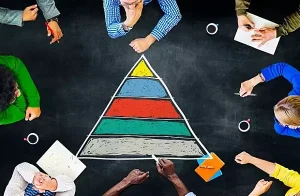Most often we are content to make adjustments to rewards and sanctions, but we forget the other needs in Maslow’s Pyramid, essential for human resource development. Belonging to an organization is inevitable and justified by the argument that through teams within the organization people can effectively fulfill the purpose, objectives and actions that they cannot accomplish on their own.
The members of the teams of the organization need to understand that it is essential to cooperate, work together and support each other, and the common effort and organization are the key to the success of the organization. Even if there are individuals, for example experts, specialists, the chance to create an effective organization is to achieve common goals. Tailored to specific needs and resources, teams can help your organization have a clear strategy and indicators to evaluate performance and help your organization grow steadily. Developing team management with the help of a leader is a key concept in the development of the organization’s performance.
The relationship between leadership and human resource within the team
Currently, more and more organizations are facing the need to increase labor productivity and for this they have material resources and access to technologies. One of the least exploited ways to increase productivity is to improve human performance.
The moment we face a problem, we must focus our efforts on overcoming it. There are cases when it can be solved by one person, there are cases when we need to form a team for a successful approach to the situation. When forming a team, the problem becomes a common one, so for analyzing and achieving the long-term objectives proposed by the teams, we start from solving the problems related to motivation and communication. Regardless of the form of organization we are talking about, a leader is always the one who creates vision and leads by the power of example. The leader inspires people and gives them confidence, supports them in achieving goals.
I think it is very important for a leader to gain the trust of the team and to respect their commitments. Team members need confidence in the leader, to feel listened to and included in common tasks. A leader must know very well his team members and the role of each; be able to delegate the right tasks to team members; be able to quickly implement important decisions; have vision; be aware of problems within the team; be able to control conflicts; be adaptable; be able to motivate team members; be able to turn a group of people into a team.
No matter how big the goal that the team wants to achieve and the changes that are necessary for effective communication and organization, the effective leader focuses on the question „how to do” and not on „why we can not do”.
What do teams need to be motivated?
After the Second World War, knowing what could motivate man, psychologists Abraham Maslow and Douglas McGregor paved the way for theories of motivation. They stated that people are not all identical, but have characteristics that can be identified and even categorized. In addition to financial stimulation, the importance of the content of work and respect for the dignity of the individual has been discovered. Abraham Maslow developed a theory about motivation that continues to be a reference in the literature. It created a pyramidal classification of needs on 5 levels.
Physiological needs are those related to survival These include: food, water, oxygen, rest and clothing. In an organization, these needs are met by a minimum wage and working conditions that allow for existence.
Security needs are those related to the safety and stability of a structured and orderly environment. These needs can be met by job security, safe working conditions, fair and realistic rules and regulations, pension and insurance programs
Needs of association include needs for social interaction, affection, love, companionship and friendship. These needs can be met by the possibility to interact with others at work, the chance to work in a team, the opportunity to develop new social relationships.
Needs of esteem include the desire for appreciation and recognition from others. These needs can be met by personal achievements, promotions, professional recognition, awards, etc.
The needs for self-realization are those needs for growth and development of human potential. These needs are the most difficult to satisfy Their satisfaction differ from individual to individual and is generally ensured by posts with great potential for creativity and growth, the possibility of self-development and personal progress.
Team motivation is a key factor both for the individual performance of each employee and for the group productivity, to maintain a pleasant atmosphere at work and for the success of the projects being worked on. At the stage of forming a team, personal relationships are characterized by dependence. Members rely on safety, known behaviours and seek leadership guidance. They want to be accepted by the group and need the certainty that they will be listened to and respected for what they offer.
The question underlying this article is how does a team leader motivate the human resource within a team? It would be ideal to know all regardless of the field in which we activate that human resource is the ’’ engine of the development of the organization. In order to develop the confidence of the teams and motivate them to reach the performance, the leader needs to follow some basic rules: to communicate often with team members; to show respect for team members; to be fair to the team; to be consistent in their actions; to demonstrate competence; to provide feedback to the team regardless of results.
Motivation initiates and divides human behavior in order to determine professional fulfillment. An increased motivation leads to the installation of satisfaction in work. Employee performance, productivity, and motivation are all about how people feel at work, and how they reward for their efforts.



